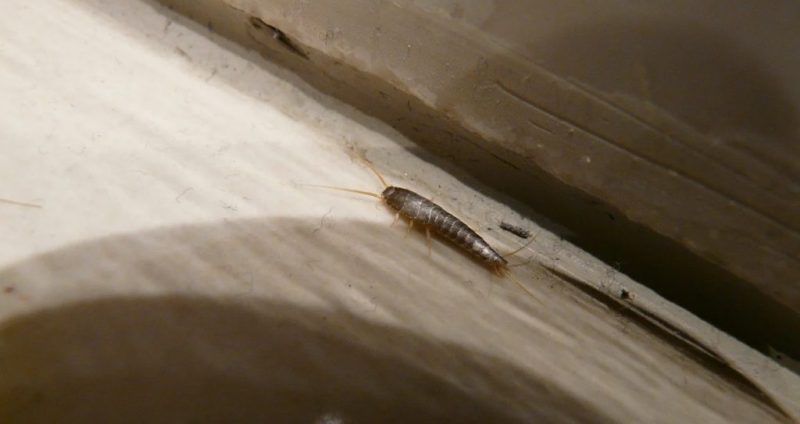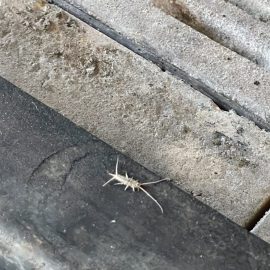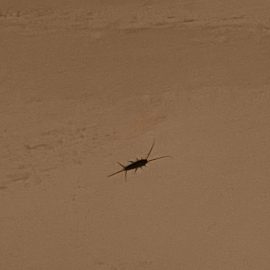How to get rid of Silverfish

Silverfish (Lepisma saccharina) are primitive, wingless insects of small sizes that belong to the order Zygentoma. They are widespread in most areas of the world and are adapted to different climatic conditions. Their common name is given by their silver, shiny appearance and the movements it makes when they move.
The scientific name “saccharin” suggests that they are consumers of foodstuffs rich in polysaccharides, such as sugar, starch, glue found in book covers, upholstery, glues, but they also consume textiles made from cotton and silk.
They are harmless insects that do not attack people and do not transmit diseases but are considered harmful because they can damage household items.
Silverfish – Signs of infestation
The presence of these insects can be observed by detecting them or their excrements, which are similar to peppercorns. Other important signs that indicate a silverfish infestation are: the appearance of yellow spots or small holes on clothes, wallpaper, cereal boxes, or cardboard.
It is important to carefully perform checks in dark places or highly humid places (bathrooms, basements, kitchens, water pipes), taking into account the fact that silverfish are most active during the night.
Preventive measures
To prevent silverfish infestations, it is advised to take several measures into account:
- insulate cracks or holes that could facilitate access areas for insects into the house;
- try to reduce the humidity in the house as much as possible;
- check incoming boxes, furniture, and construction materials before bringing them inside;
- keep the yard free of cardboard boxes or wooden materials, in which insects can take shelter;
Types of treatments
For the control of silverfish, specific insecticide sprays can be employed, and special ready-to-use insecticides and glue traps are also available.
For the treatments to have the desired results, it is very important to identify and treat possible sources and areas with a high risk of silverfish encounters.
Insecticide treatments
The application of sprayed treatments is recommended. The solution will be sprayed in all areas where they could hide (cracks near baseboards, near windows or doors, cabinets, isolated spaces, areas through which water pipes pass). The insecticide solution can be applied with any type of sprayer.
Recommended insecticides:
Biocidal substances are used for treatments against silverfish, most of which act on the insect’s nervous system. Concentrated contact insecticides, soluble in water, are preferred against silverfish, following the recommended dosages. The solution is applied by spraying, using manual or motorized equipment, depending on the size of the space that is being treated.
Recommended products
-
You can find products on a different store
Change Store -
You can find products on a different store
Change Store -
You can find products on a different store
Change Store -
You can find products on a different store
Change Store -
You can find products on a different store
Change Store -
You can find products on a different store
Change Store -
You can find products on a different store
Change Store -
You can find products on a different store
Change Store -
You can find products on a different store
Change Store -
You can find products on a different store
Change Store -
You can find products on a different store
Change Store -
You can find products on a different store
Change Store -
You can find products on a different store
Change Store -
You can find products on a different store
Change Store -
You can find products on a different store
Change Store -
You can find products on a different store
Change Store -
You can find products on a different store
Change Store -
You can find products on a different store
Change Store -
You can find products on a different store
Change Store -
You can find products on a different store
Change Store -
You can find products on a different store
Change Store -
You can find products on a different store
Change Store -
You can find products on a different store
Change Store -
You can find products on a different store
Change Store
Recommended sprayers for the application of insecticides:
Sprayers are low-pressure applicators, which are used for the application of pesticides that require precise dosing. Their capacity varies depending on the type of appliance, its design, the application method (manual / motorized sprayers), and the size of the treated space. Special care must be had when adjusting the device, as well as when performing maintenance.
Recommended products
-
You can find products on a different store
Change Store -
You can find products on a different store
Change Store -
You can find products on a different store
Change Store -
You can find products on a different store
Change Store -
You can find products on a different store
Change Store -
You can find products on a different store
Change Store -
You can find products on a different store
Change Store -
You can find products on a different store
Change Store -
You can find products on a different store
Change Store -
You can find products on a different store
Change Store -
You can find products on a different store
Change Store -
You can find products on a different store
Change Store -
You can find products on a different store
Change Store -
You can find products on a different store
Change Store -
You can find products on a different store
Change Store -
You can find products on a different store
Change Store -
You can find products on a different store
Change Store -
You can find products on a different store
Change Store -
You can find products on a different store
Change Store -
You can find products on a different store
Change Store -
You can find products on a different store
Change Store -
You can find products on a different store
Change Store -
You can find products on a different store
Change Store -
You can find products on a different store
Change Store
Ready-to-use insecticide treatments
They are recommended for hard-to-reach spaces, where spray treatments cannot be applied (for example cracks, voids, narrow spaces). Ready-to-use insecticides can be found in the form of dust, granules, liquids, or sprays.
Taking into consideration that liquid insecticides cannot be applied onto electrical installations, ventilation systems, etc., in such cases granular or dust insecticides will be used. Ready-to-use insecticides should only be applied to dry surfaces.
Recommended ready-to-use insecticides:
Ready-to-use insecticides can come in the following forms: dust, liquids, sprays, and granules. The application is made according to the space that is being treated, taking into account the information provided on the product label. These insecticides are intended for use in areas where sprayed insecticides cannot be used.
Recommended products
-
You can find products on a different store
Change Store -
You can find products on a different store
Change Store -
You can find products on a different store
Change Store -
You can find products on a different store
Change Store -
You can find products on a different store
Change Store -
You can find products on a different store
Change Store -
You can find products on a different store
Change Store -
You can find products on a different store
Change Store -
You can find products on a different store
Change Store -
You can find products on a different store
Change Store -
You can find products on a different store
Change Store -
You can find products on a different store
Change Store -
You can find products on a different store
Change Store -
You can find products on a different store
Change Store -
You can find products on a different store
Change Store -
You can find products on a different store
Change Store -
You can find products on a different store
Change Store -
You can find products on a different store
Change Store -
You can find products on a different store
Change Store -
You can find products on a different store
Change Store -
You can find products on a different store
Change Store -
You can find products on a different store
Change Store -
You can find products on a different store
Change Store -
You can find products on a different store
Change Store
In hard-to-reach areas, insecticide dust can be applied with the help of a special duster.
Recommended dusters for the application of powder insecticides:
Dusters are devices specially designed for the application of granular or powder (dust) products. They are used for the treatment of hard-to-reach spaces, such as inside walls (cracks), behind panels, spaces around electrical outlets, and in very narrow spaces.
Recommended products
-
You can find products on a different store
Change Store -
You can find products on a different store
Change Store -
You can find products on a different store
Change Store -
You can find products on a different store
Change Store -
You can find products on a different store
Change Store -
You can find products on a different store
Change Store -
You can find products on a different store
Change Store -
You can find products on a different store
Change Store -
You can find products on a different store
Change Store -
You can find products on a different store
Change Store -
You can find products on a different store
Change Store -
You can find products on a different store
Change Store -
You can find products on a different store
Change Store -
You can find products on a different store
Change Store -
You can find products on a different store
Change Store -
You can find products on a different store
Change Store -
You can find products on a different store
Change Store -
You can find products on a different store
Change Store -
You can find products on a different store
Change Store -
You can find products on a different store
Change Store -
You can find products on a different store
Change Store -
You can find products on a different store
Change Store -
You can find products on a different store
Change Store -
You can find products on a different store
Change Store
Glue traps
The glue traps contain a special attractant with the role of baiting silverfish that cross the area of action of the trap, to lure and trap them on the sticky surface. The traps are placed as close as possible to areas where silverfish activity has been detected (underneath furniture, in bathrooms, on bookshelves, in clothing storage areas, in kitchens and basement, near food sources, etc.).
Besides the control of silverfish populations, traps can also be used to monitor their activity (to detect the presence and determine the degree of infestation in a certain space, to carry out treatments).
Traps can be placed even after the application of chemical treatments to verify their results and monitor the treated space. Subsequently, depending on the number of pests caught on the trap, additional chemical treatments can be considered.
Recommended glue traps for the control of silverfish:
They are plastic boxes or strips covered by a layer of glue. Glue traps have the role of trapping pests on the sticky surface and helping monitor their activity. In addition to the adhesive component, the traps contain an attractant that entices the pests to approach the trap and remain stuck to it. Their size and design differ depending on the type of pest for which they are intended. Some traps can catch several types of pests at the same time. The traps are removed together with the pests caught in the glue.
Recommended products
-
You can find products on a different store
Change Store -
You can find products on a different store
Change Store -
You can find products on a different store
Change Store -
You can find products on a different store
Change Store -
You can find products on a different store
Change Store -
You can find products on a different store
Change Store -
You can find products on a different store
Change Store -
You can find products on a different store
Change Store -
You can find products on a different store
Change Store -
You can find products on a different store
Change Store -
You can find products on a different store
Change Store -
You can find products on a different store
Change Store -
You can find products on a different store
Change Store -
You can find products on a different store
Change Store -
You can find products on a different store
Change Store -
You can find products on a different store
Change Store -
You can find products on a different store
Change Store -
You can find products on a different store
Change Store -
You can find products on a different store
Change Store -
You can find products on a different store
Change Store -
You can find products on a different store
Change Store -
You can find products on a different store
Change Store -
You can find products on a different store
Change Store -
You can find products on a different store
Change Store
Silverfish repellents
They are products used to ward off silverfish. Due to their organoleptic properties, repellents create olfactory barriers and produce unpleasant sensations for the target species, discouraging their activity in the treated areas.
Silverfish multiply fast and can quickly become invasive in a short time. To get rid of these insects, control measures must be taken from the first signs of infestation. Thus, it is recommended to apply specific insecticides and place glue traps.
To prevent the infestation, it is recommended to seal off possible access ways into the house, reduce the levels of humidity inside the building, eliminate potential food sources, maintain a clean environment, etc.

















































































































































































































































































































































































































































